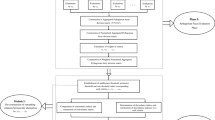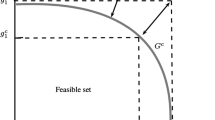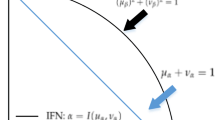Abstract
ELECTRE is a family of multi-criteria decision analysis techniques which has the ability to provide as much as possible precise and suitable set of actions or alternatives to the underlying problem by eliminating the alternatives which are outranked by others. Group decision making is an effective process to provide the most appropriate solution to real-world decision-making scenarios by considering and merging the expert opinions of multiple individuals on problem. The purpose of this research study is to extend the ELECTRE I method to Pythagorean fuzzy ELECTRE I (PF-ELECTRE I) method in group decision-making environment, as Pythagorean fuzzy set model is more superior tool to capture vagueness and incompleteness in human evaluations. The developed method has ability to solve multi-criteria group decision-making problems in which the assessment information on available alternatives, provided by the experts, is presented as Pythagorean fuzzy decision matrices having each entry characterized by Pythagorean fuzzy number (PFN). The approach is formulated by introducing the concepts of strong, midrange and weak Pythagorean fuzzy concordance and discordance sets to elaborate the outranking relation among alternatives with respect to conflicting criteria. Framework of group decision supporting system based on PF-ELECTRE I is demonstrated by a flowchart. Finally, two illustrative examples in the field of health safety and environment management are given to verify and demonstrate the applicability of our proposed approach.





Similar content being viewed by others
Explore related subjects
Discover the latest articles, news and stories from top researchers in related subjects.References
Aiello G, Enea M, Galante G (2006) A multi-objective approach to facility layout problem by genetic search algorithm and Electre method. Robot Comput Integr Manuf 22(5–6):447–455
Akram M, Ali G (2018) Hybrid models for decision-making based on rough Pythagorean fuzzy bipolar soft information. Granul Comput. https://doi.org/10.1007/s41066-018-0132-3
Akram M, Naz S (2018) Energy of Pythagorean fuzzy graphs with applications. Mathematics 6(8):136. https://doi.org/10.3390/math6080136
Akram M, Shumaiza Smarandache F (2018) Decision-making with bipolar neutrosophic TOPSIS and bipolar neutrosophic ELECTRE-I. Axioms 7(2):33. https://doi.org/10.3390/axioms7020033
Akram M, Habib A, Ilyas F, Dar JM (2018) Specific types of Pythagorean fuzzy graphs and application to decision-making. Math Comput Appl 23(3):42. https://doi.org/10.3390/mca23030042
Akram M, Dar JM, Farooq A (2018) Planar graphs under Pythagorean fuzzy environment. Mathematics 6(12):278. https://doi.org/10.3390/math6120278
Akram M, Ilyas F, Saeid AB (2019a) Certain notions of Pythagorean fuzzy graphs. J Intell Fuzzy Syst. https://doi.org/10.3233/JIFS-181697
Akram M, Ilyas F, Dudek WA (2019b) Group decisionĄmaking based on pythagorean fuzzy TOPSIS method. Int J Intell Syst. https://doi.org/10.1002/int.22103
Akram M, Dar JM, Naz S (2019c) Certain graphs under Pythagorean fuzzy environment. Complex Intell Syst. https://doi.org/10.1007/s40747-018-0089-5
Akram M, Habib A, Davvaz B (2019d) Direct sum of n Pythagorean fuzzy graphs with application to group decision-making. J Multiple Valued Log Soft Comput (in press)
Alghamdi MA, Alshehri NO, Akram M (2018) Multi-criteria decision-making methods in bipolar fuzzy environment. Int J Fuzzy Syst 20(6):2057–2064
Arkan E, Kalender ZTS, Vayvay Ö (2017) Solid waste disposal methodology selection using multi-criteria decision making methods and an application in Turkey. J Clean Prod 142:403–412
Atanassov KT (1983) Intuitionistic fuzzy sets. VII ITKR’s Session, Sofia, Deposed in Central Sci. - Techn. Library of Bulg. Acad. of Sci., 1697/84, (in Bulgarian)
Aytac E, Kundaki N, Isik AT (2011) Fuzzy ELECTRE I method for evaluating catering firm alternatives. Ege Acad Rev 11:125–134
Beccali M, Cellura M, Mistretta M (2003) Decision-making in energy planning. Application of the Electre method at regional level for the diffusion of renewable energy technology. Renew Energy 28(13):2063–2087
Benayoun R, Roy B, Sussman B (1966) ELECTRE: Une méthode pour guider le choix en présence de points de vue multiples. Note de travail 49, SEMA-METRA international, direction scientifique
Botti L, Peypoch N (2013) Multi-criteria ELECTRE method and destination competitiveness. Tour Manag Perspect 6:108–113
Brans JP, Vinvke P, Mareschal B (1986) How to select and how to rank projects: the PROMETHEE method. Eur J Oper Res 24:228–238
Chen TY (2014) An ELECTRE-based outranking method for multiple criteria group decision making using interval type-2 fuzzy sets. Inf Sci 263:1–21
de Almeida AT (2007) Multicriteria decision model for outsourcing contracts selection based on utility function and ELECTRE method. Comput Oper Res 34(12):3569–3574
Figueira JR, Mousseau V, Roy B (2005) ELECTRE methods. In: Figueira J, Greco S, Ehrgott M (eds) Multiple criteria decision analysis: the state of the art surveys. Springer, New York, pp 133–162
Garg H (2016) A novel correlation coefficients between Pythagorean fuzzy sets and its applications to decision-making processes. Int J Intell Syst Wiley 31(12):1234–1253
Garg H (2018) Linguistic Pythagorean fuzzy sets and its applications in multi attribute decision making process. Int J Intell Syst Wiley 33(6):1234–1263
Garg H (2018) Hesitant Pythagorean fuzzy sets and their aggregation operators in multiple-attribute decision-making. Int J Uncertain Quantif 8(3):267–289
Hajeeh M, AI-Othman A (2005) Application of the analytical hierarchy process in the selection of desalination plants. Desalination 174:97–108
Hwang CL, Yoon K (1981) Multiple attribute decision making: methods and applications. Springer, Berlin
Krylovas A (2014) New KEMIRA method for determining criteria priority and weights in solving MCDM problem. Int J Inf Technol Decis Mak 13:1119–1133
Naz S, Ashraf S, Akram M (2018) A novel approach to decision making with Pythagorean fuzzy information. Mathematics 6(6):95. https://doi.org/10.3390/math6060095
Opricovic S, Tzeng GH (2004) Compromise solution by MCDM methods: a comparative analysis of VIKOR and TOPSIS. Eur J Oper Res 156(2):445–455
Peng X, Selvachandran G (2017) Pythagorean fuzzy set: state of the art and future directions. Artif Intell Rev. https://doi.org/10.1007/s10462-017-9596-9
Peng XD, Yang Y (2015) Some results for Pythagorean fuzzy sets. Int J Intell Syst 30(11):1133–1160
Peng X, Yang Y (2016) Fundamental properties of interval-valued Pythagorean fuzzy aggregation operators. Int J Intell Syst 31:444–487
Peng JJ, Wang JQ, Zhang HY, Chen XH (2014) An outranking approach for multi-criteria decision-making problems with simplified neutrosophic sets. Appl Soft Comput 25:336–346
Pramanik T, Samanta S, Sarkar B, Pal M (2016) Fuzzy \(\phi \)-tolerance competition graphs. Soft Comput. https://doi.org/10.1007/s00500-015-2026-5
Ren PJ, Xu ZS, Gou XJ (2016) Pythagorean fuzzy TODIM approach to multicriteria decision making. Appl Soft Comput 42:246–259
Rogers M, Bruen M (1998) Choosing realistic values of indifference, preference and veto thresholds for use with environmental criteria within ELECTRE. Eur J Oper Res 107(3):542–551
Roy B (1968) Classement et choix en présence de points de vue multiples (la méthode ELECTRE). RIRO 8:57–75
Singh PK, Kumar AC, Li J (2016) Knowledge representation using interval-valued fuzzy formal concept lattice. Soft Comput 20(4):1485–1502
Vahdani B, Hadipour H (2011) Extension of the ELECTRE method based on interval-valued fuzzy sets. Soft Comput 15(3):569–579
Vahdani B, Mousavi SM, Moghaddam RT, Hashemi H (2013) A new design of the elimination and choice translating reality method for multi-criteria group decision-making in an intuitionistic fuzzy environment. Appl Math Model 37:1781–1799
Wu MC, Chen TY (2011) The ELECTRE multicriteria analysis approach based on Atanssov’s intuitionistic fuzzy sets. Expert Syst Appl 38:12318–12327
Yager RR (2013) Pythagorean fuzzy subsets. In: Proceedings of the Joint IFSA world congress and NAFIPS annual meeting, Edmonton, Canada, pp 57-61
Yager RR, Abbasov AM (2013) Pythagorean membership grades, complex numbers, and decision making. Int J Intell Syst 28(5):436–452
Zadeh LA (1965) Fuzzy sets. Inf Control 8(3):338–353
Zhan J, Masood H, Akram M (2018a) Novel decision-making algorithms based on intuitionistic fuzzy rough environment. Int J Mach Learn Cybern. https://doi.org/10.1007/s13042-018-0827-4
Zhan J, Akram M, Sitara M (2018b) Novel decision-making method based on bipolar neutrosophic information. Soft Comput. https://doi.org/10.1007/s00500-018-3552-8
Zhang X (2016) A novel approach based on similarity measure for pythagorean fuzzy multiple criteria group decision making. Int J Intell Syst 31(6):593–611
Zhang X, Xu Z (2014) Extension of TOPSIS to multiple criteria decision making with Pythagorean fuzzy sets. Int J Intell Syst 29(12):1061–1078
Author information
Authors and Affiliations
Corresponding author
Ethics declarations
Conflict of interest
The authors declare that they have no conflict of interest.
Ethical approval
This article does not contain any studies with human participants or animals performed by any of the authors.
Additional information
Communicated by V. Loia.
Publisher's Note
Springer Nature remains neutral with regard to jurisdictional claims in published maps and institutional affiliations.
Rights and permissions
About this article
Cite this article
Akram, M., Ilyas, F. & Garg, H. Multi-criteria group decision making based on ELECTRE I method in Pythagorean fuzzy information. Soft Comput 24, 3425–3453 (2020). https://doi.org/10.1007/s00500-019-04105-0
Published:
Issue Date:
DOI: https://doi.org/10.1007/s00500-019-04105-0




